Project Management: Risk Register and Project Initiation Document
VerifiedAdded on 2023/01/13
|19
|3736
|53
AI Summary
This document provides information about the project initiation document and risk register in project management. It explains the importance of these documents in planning and executing a project. The risk register helps in identifying potential risks and developing strategies to mitigate them. It also discusses the criticality of the risk register in project management.
Contribute Materials
Your contribution can guide someone’s learning journey. Share your
documents today.
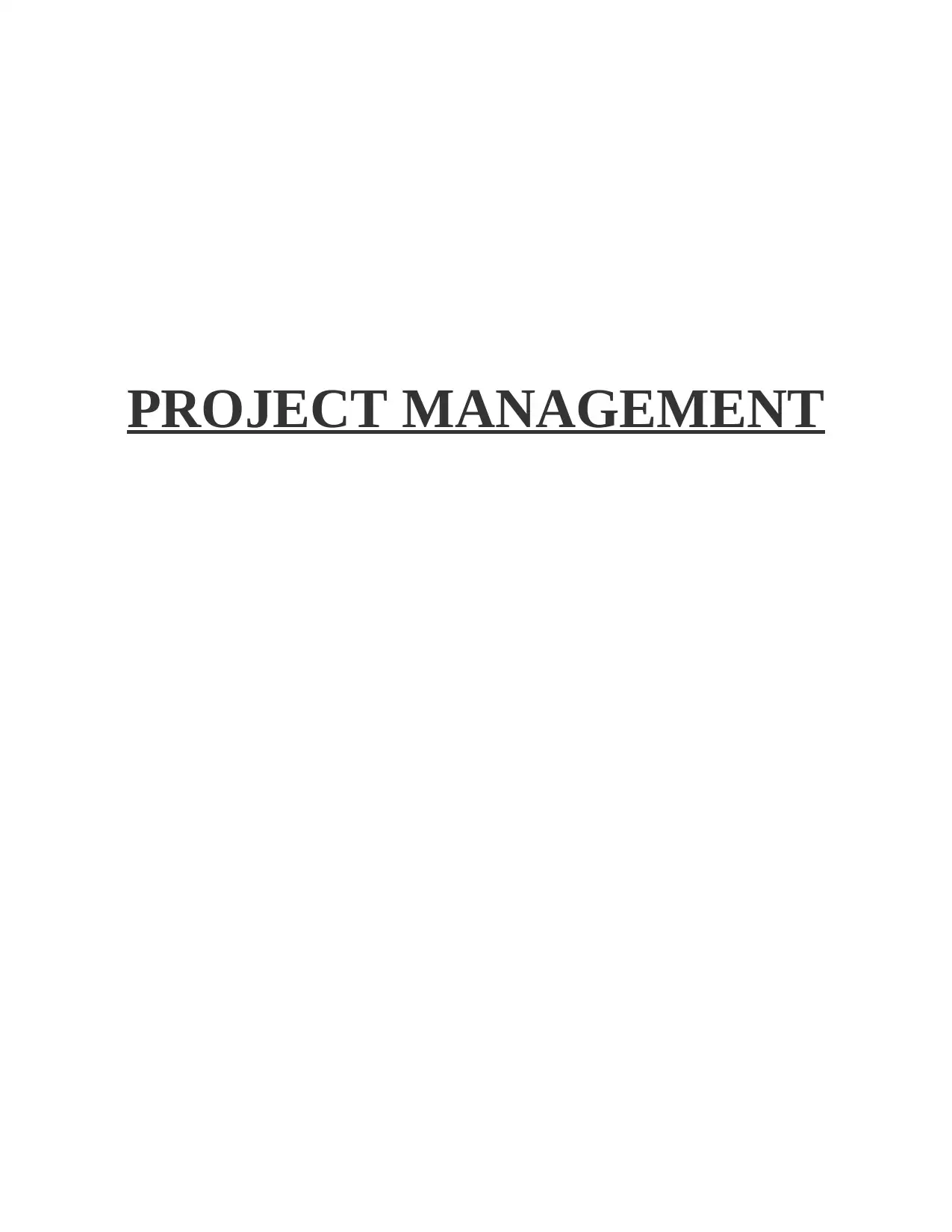
PROJECT MANAGEMENT
Secure Best Marks with AI Grader
Need help grading? Try our AI Grader for instant feedback on your assignments.
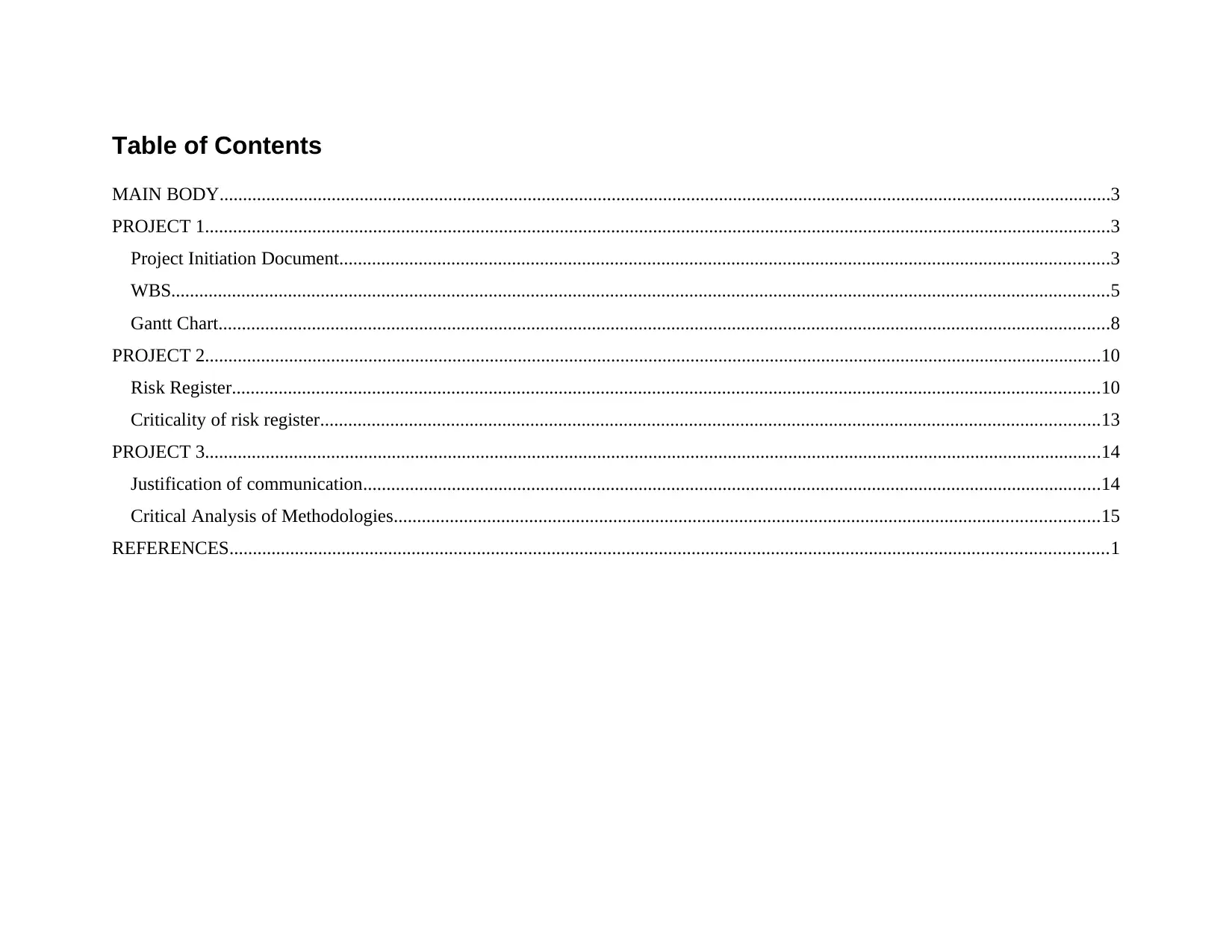
Table of Contents
MAIN BODY...............................................................................................................................................................................................3
PROJECT 1..................................................................................................................................................................................................3
Project Initiation Document.....................................................................................................................................................................3
WBS.........................................................................................................................................................................................................5
Gantt Chart...............................................................................................................................................................................................8
PROJECT 2................................................................................................................................................................................................10
Risk Register..........................................................................................................................................................................................10
Criticality of risk register.......................................................................................................................................................................13
PROJECT 3................................................................................................................................................................................................14
Justification of communication..............................................................................................................................................................14
Critical Analysis of Methodologies.......................................................................................................................................................15
REFERENCES............................................................................................................................................................................................1
MAIN BODY...............................................................................................................................................................................................3
PROJECT 1..................................................................................................................................................................................................3
Project Initiation Document.....................................................................................................................................................................3
WBS.........................................................................................................................................................................................................5
Gantt Chart...............................................................................................................................................................................................8
PROJECT 2................................................................................................................................................................................................10
Risk Register..........................................................................................................................................................................................10
Criticality of risk register.......................................................................................................................................................................13
PROJECT 3................................................................................................................................................................................................14
Justification of communication..............................................................................................................................................................14
Critical Analysis of Methodologies.......................................................................................................................................................15
REFERENCES............................................................................................................................................................................................1

MAIN BODY
PROJECT 1
Project Initiation Document
The Project Initiation document also referred as the project charter details all the steps that will be followed and activities to be
completed in a chronological order and the entire project life cycle is enumerated (Kerzner, 2018). Some important elements of a PID
are:
Budget: Budget helps in determining what is the expected amount of expenditures on different activities and help in minimizing over
or under spending (Fewings and Henjewele, 2019). In order to conduct the sports event successfully for QAHE London, there needs to
be a budget for the 10 HEIs that will be competing in the Sports event or competition.
Particulars Amount (Per HEI) Amount (Total)
Suppliers and Vendors £80 £800
Food and Catering £100 £1000
Marketing and Promotion £300 £3000
Sports Equipment and staff £500 £5000
Awards £150 £1500
Stationary £70 £700
Venue £800 £8000
Total £2000 £20000
Therefore, on the basis of £2000 for each Higher Education University, there will be collectively £20k for the QAHE University,
London.
PROJECT 1
Project Initiation Document
The Project Initiation document also referred as the project charter details all the steps that will be followed and activities to be
completed in a chronological order and the entire project life cycle is enumerated (Kerzner, 2018). Some important elements of a PID
are:
Budget: Budget helps in determining what is the expected amount of expenditures on different activities and help in minimizing over
or under spending (Fewings and Henjewele, 2019). In order to conduct the sports event successfully for QAHE London, there needs to
be a budget for the 10 HEIs that will be competing in the Sports event or competition.
Particulars Amount (Per HEI) Amount (Total)
Suppliers and Vendors £80 £800
Food and Catering £100 £1000
Marketing and Promotion £300 £3000
Sports Equipment and staff £500 £5000
Awards £150 £1500
Stationary £70 £700
Venue £800 £8000
Total £2000 £20000
Therefore, on the basis of £2000 for each Higher Education University, there will be collectively £20k for the QAHE University,
London.
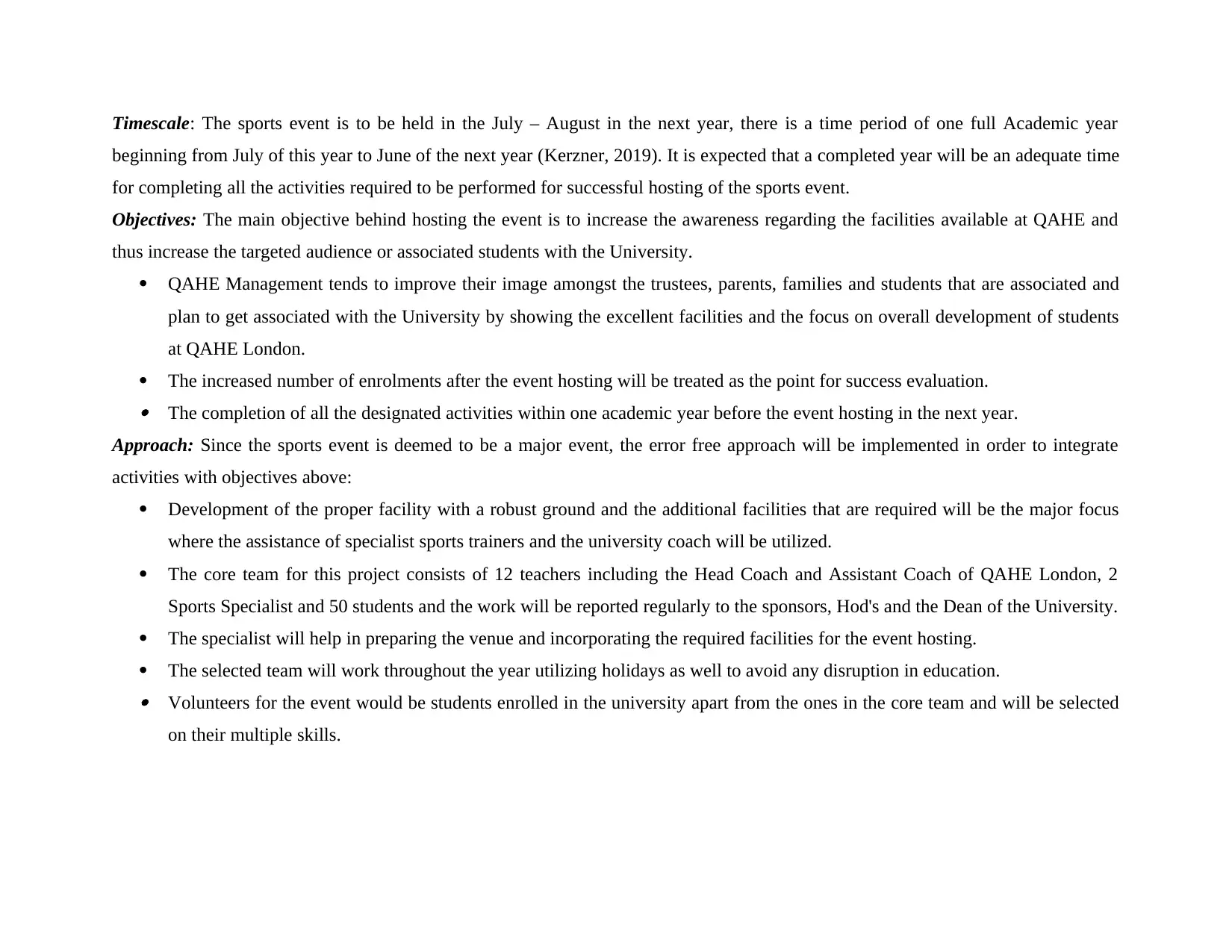
Timescale: The sports event is to be held in the July – August in the next year, there is a time period of one full Academic year
beginning from July of this year to June of the next year (Kerzner, 2019). It is expected that a completed year will be an adequate time
for completing all the activities required to be performed for successful hosting of the sports event.
Objectives: The main objective behind hosting the event is to increase the awareness regarding the facilities available at QAHE and
thus increase the targeted audience or associated students with the University.
QAHE Management tends to improve their image amongst the trustees, parents, families and students that are associated and
plan to get associated with the University by showing the excellent facilities and the focus on overall development of students
at QAHE London.
The increased number of enrolments after the event hosting will be treated as the point for success evaluation. The completion of all the designated activities within one academic year before the event hosting in the next year.
Approach: Since the sports event is deemed to be a major event, the error free approach will be implemented in order to integrate
activities with objectives above:
Development of the proper facility with a robust ground and the additional facilities that are required will be the major focus
where the assistance of specialist sports trainers and the university coach will be utilized.
The core team for this project consists of 12 teachers including the Head Coach and Assistant Coach of QAHE London, 2
Sports Specialist and 50 students and the work will be reported regularly to the sponsors, Hod's and the Dean of the University.
The specialist will help in preparing the venue and incorporating the required facilities for the event hosting.
The selected team will work throughout the year utilizing holidays as well to avoid any disruption in education. Volunteers for the event would be students enrolled in the university apart from the ones in the core team and will be selected
on their multiple skills.
beginning from July of this year to June of the next year (Kerzner, 2019). It is expected that a completed year will be an adequate time
for completing all the activities required to be performed for successful hosting of the sports event.
Objectives: The main objective behind hosting the event is to increase the awareness regarding the facilities available at QAHE and
thus increase the targeted audience or associated students with the University.
QAHE Management tends to improve their image amongst the trustees, parents, families and students that are associated and
plan to get associated with the University by showing the excellent facilities and the focus on overall development of students
at QAHE London.
The increased number of enrolments after the event hosting will be treated as the point for success evaluation. The completion of all the designated activities within one academic year before the event hosting in the next year.
Approach: Since the sports event is deemed to be a major event, the error free approach will be implemented in order to integrate
activities with objectives above:
Development of the proper facility with a robust ground and the additional facilities that are required will be the major focus
where the assistance of specialist sports trainers and the university coach will be utilized.
The core team for this project consists of 12 teachers including the Head Coach and Assistant Coach of QAHE London, 2
Sports Specialist and 50 students and the work will be reported regularly to the sponsors, Hod's and the Dean of the University.
The specialist will help in preparing the venue and incorporating the required facilities for the event hosting.
The selected team will work throughout the year utilizing holidays as well to avoid any disruption in education. Volunteers for the event would be students enrolled in the university apart from the ones in the core team and will be selected
on their multiple skills.
Paraphrase This Document
Need a fresh take? Get an instant paraphrase of this document with our AI Paraphraser
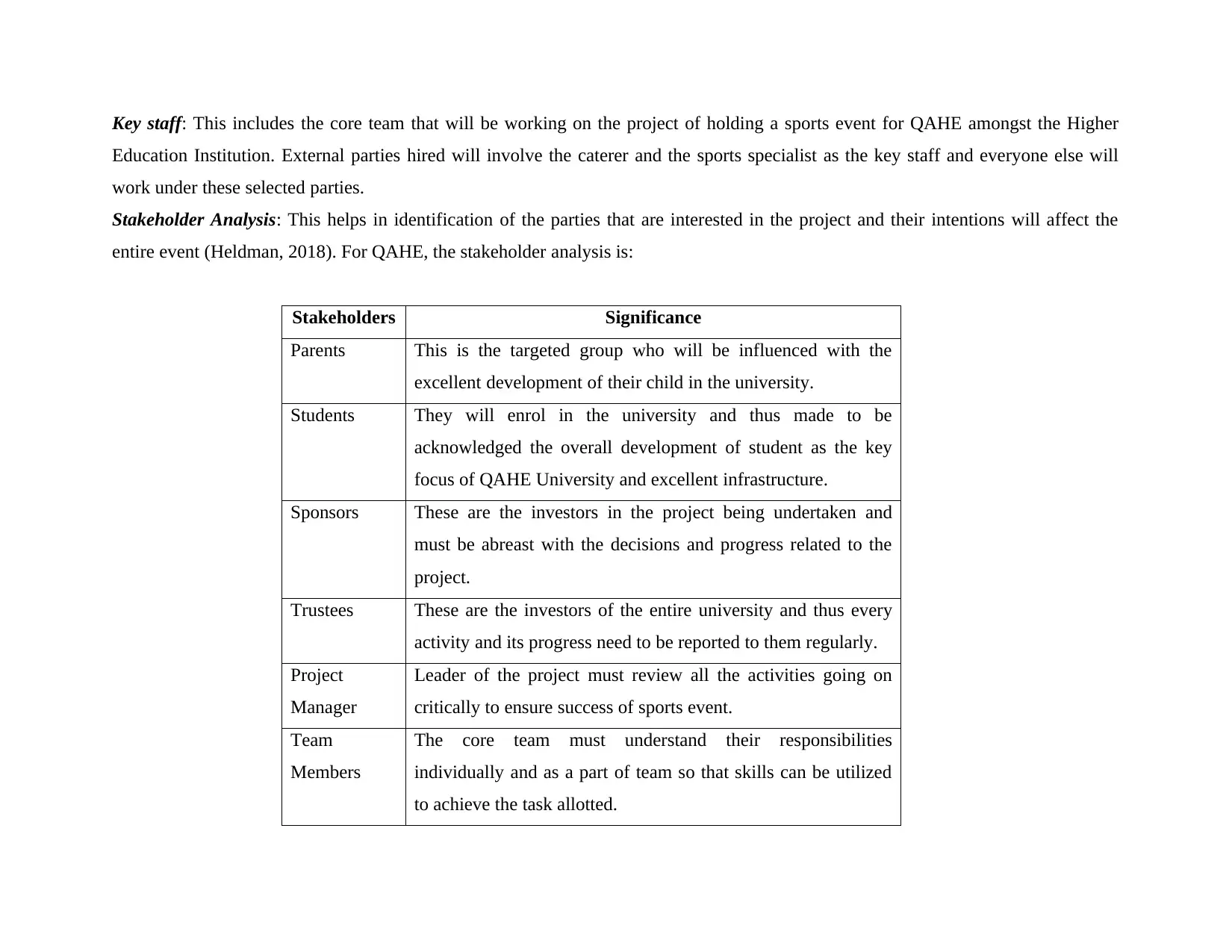
Key staff: This includes the core team that will be working on the project of holding a sports event for QAHE amongst the Higher
Education Institution. External parties hired will involve the caterer and the sports specialist as the key staff and everyone else will
work under these selected parties.
Stakeholder Analysis: This helps in identification of the parties that are interested in the project and their intentions will affect the
entire event (Heldman, 2018). For QAHE, the stakeholder analysis is:
Stakeholders Significance
Parents This is the targeted group who will be influenced with the
excellent development of their child in the university.
Students They will enrol in the university and thus made to be
acknowledged the overall development of student as the key
focus of QAHE University and excellent infrastructure.
Sponsors These are the investors in the project being undertaken and
must be abreast with the decisions and progress related to the
project.
Trustees These are the investors of the entire university and thus every
activity and its progress need to be reported to them regularly.
Project
Manager
Leader of the project must review all the activities going on
critically to ensure success of sports event.
Team
Members
The core team must understand their responsibilities
individually and as a part of team so that skills can be utilized
to achieve the task allotted.
Education Institution. External parties hired will involve the caterer and the sports specialist as the key staff and everyone else will
work under these selected parties.
Stakeholder Analysis: This helps in identification of the parties that are interested in the project and their intentions will affect the
entire event (Heldman, 2018). For QAHE, the stakeholder analysis is:
Stakeholders Significance
Parents This is the targeted group who will be influenced with the
excellent development of their child in the university.
Students They will enrol in the university and thus made to be
acknowledged the overall development of student as the key
focus of QAHE University and excellent infrastructure.
Sponsors These are the investors in the project being undertaken and
must be abreast with the decisions and progress related to the
project.
Trustees These are the investors of the entire university and thus every
activity and its progress need to be reported to them regularly.
Project
Manager
Leader of the project must review all the activities going on
critically to ensure success of sports event.
Team
Members
The core team must understand their responsibilities
individually and as a part of team so that skills can be utilized
to achieve the task allotted.
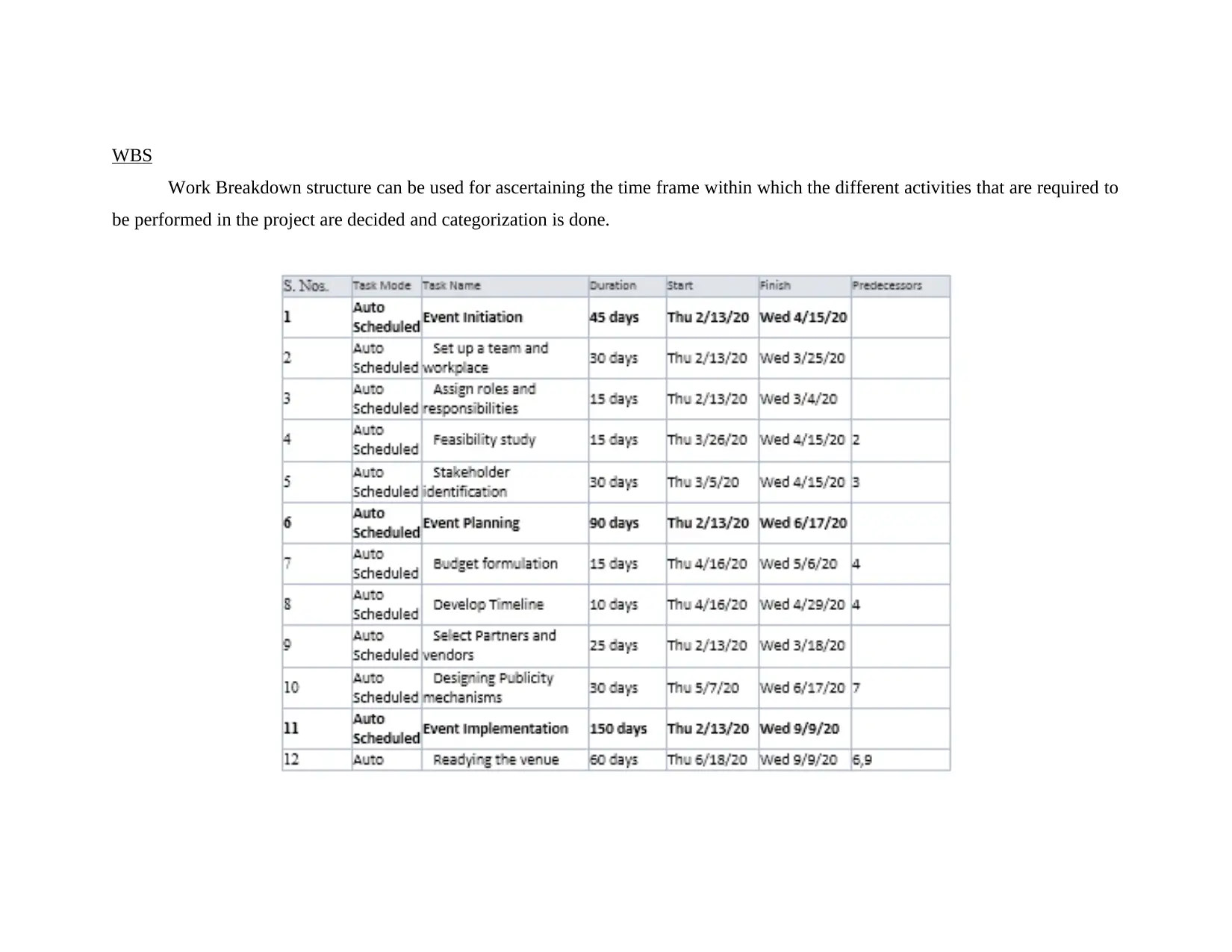
WBS
Work Breakdown structure can be used for ascertaining the time frame within which the different activities that are required to
be performed in the project are decided and categorization is done.
Work Breakdown structure can be used for ascertaining the time frame within which the different activities that are required to
be performed in the project are decided and categorization is done.
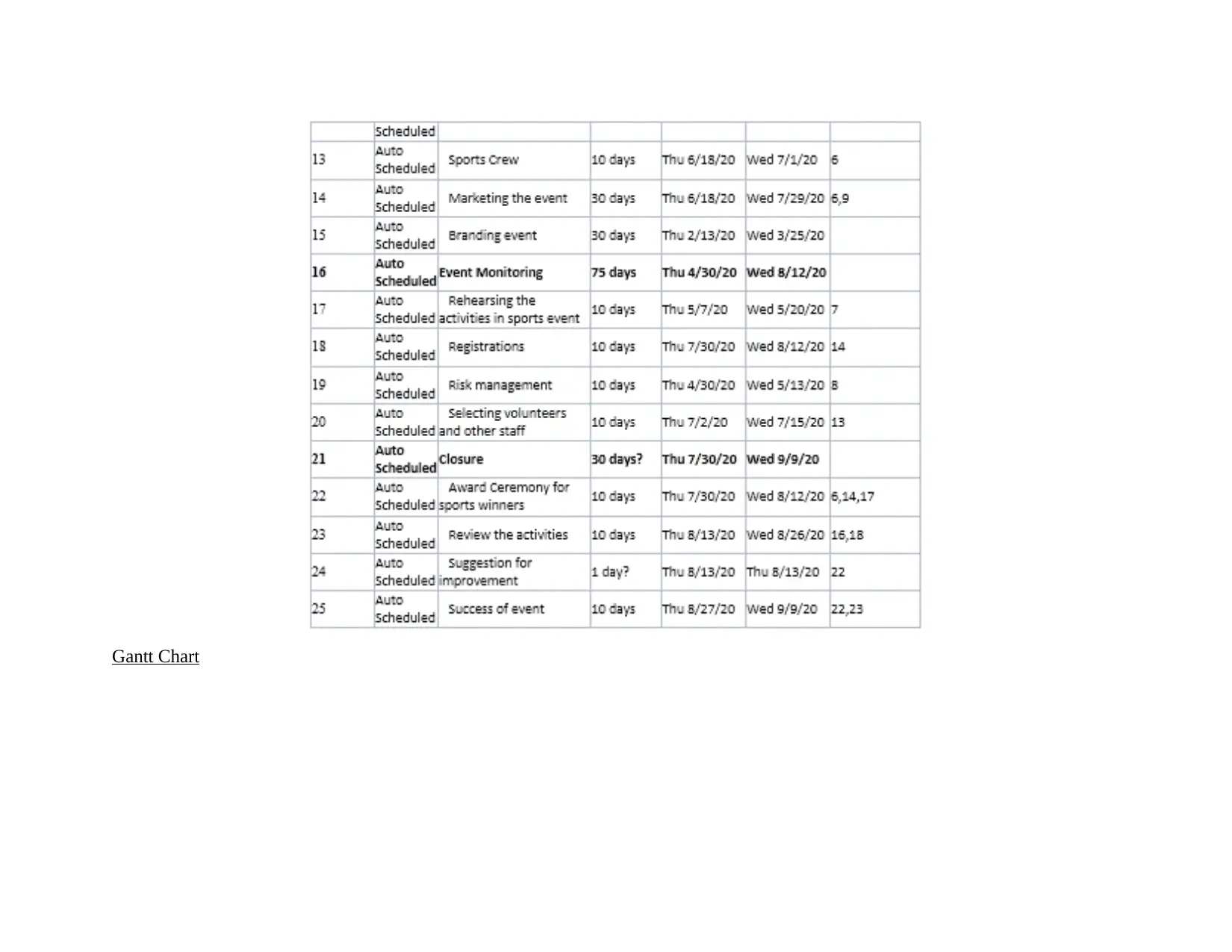
Gantt Chart
Secure Best Marks with AI Grader
Need help grading? Try our AI Grader for instant feedback on your assignments.
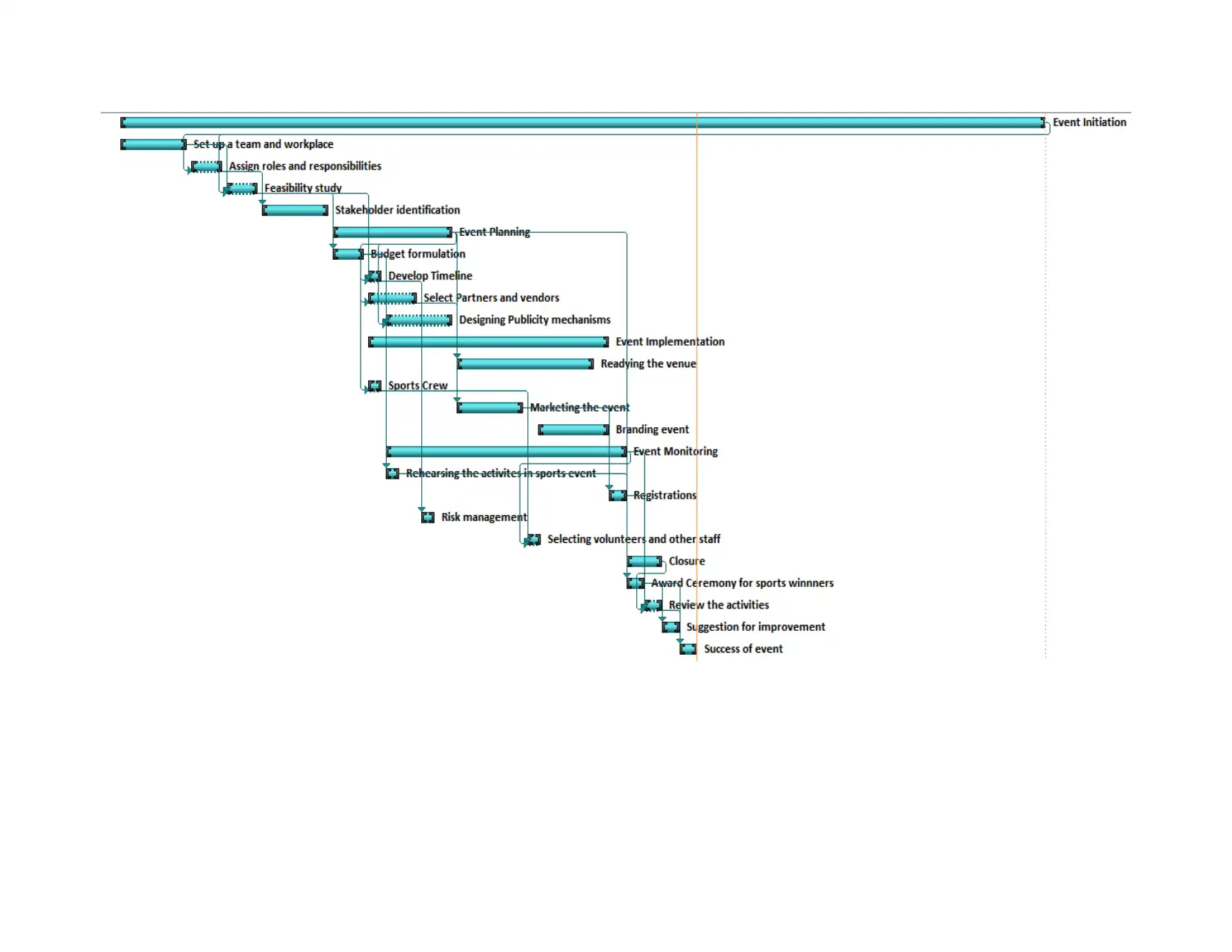
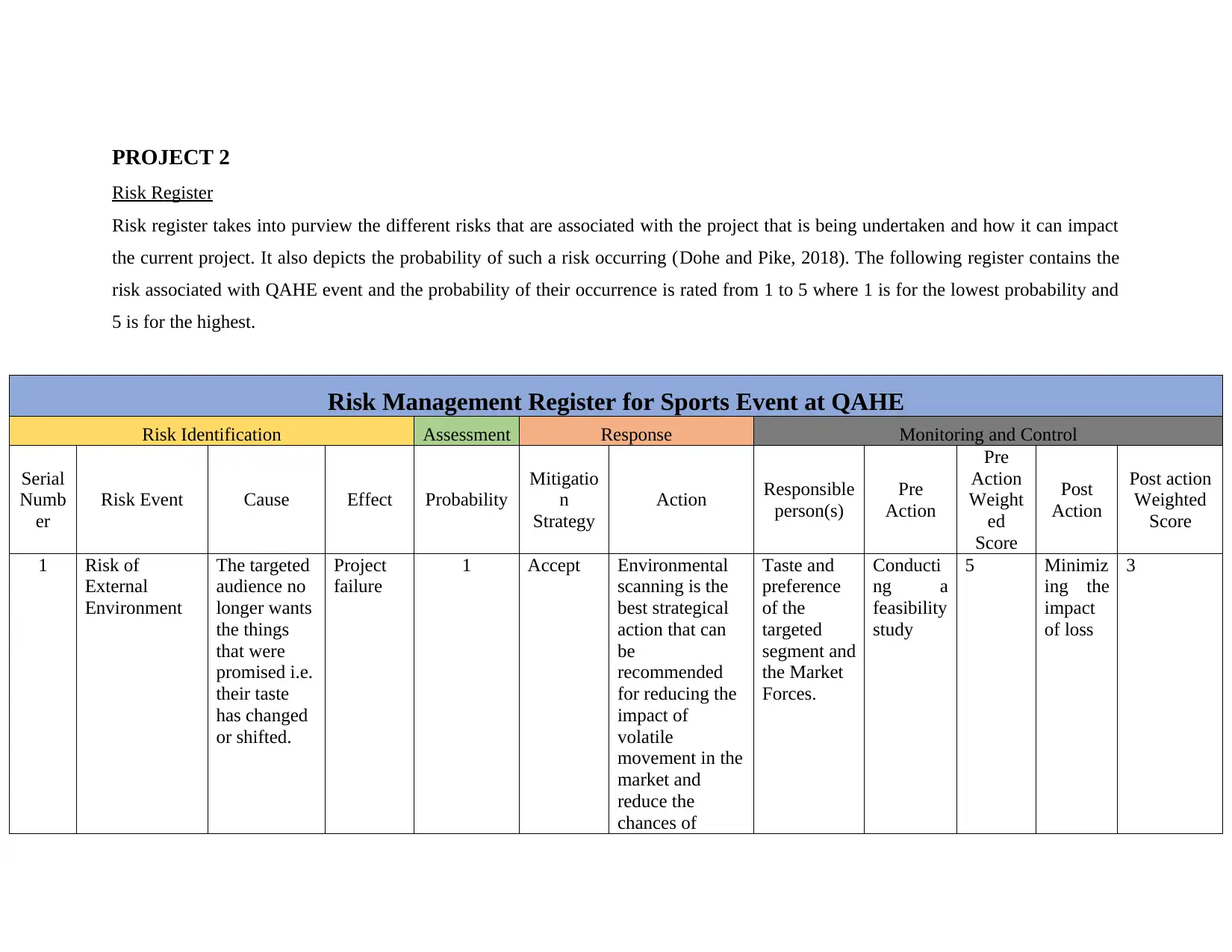
PROJECT 2
Risk Register
Risk register takes into purview the different risks that are associated with the project that is being undertaken and how it can impact
the current project. It also depicts the probability of such a risk occurring (Dohe and Pike, 2018). The following register contains the
risk associated with QAHE event and the probability of their occurrence is rated from 1 to 5 where 1 is for the lowest probability and
5 is for the highest.
Risk Management Register for Sports Event at QAHE
Risk Identification Assessment Response Monitoring and Control
Serial
Numb
er
Risk Event Cause Effect Probability
Mitigatio
n
Strategy
Action Responsible
person(s)
Pre
Action
Pre
Action
Weight
ed
Score
Post
Action
Post action
Weighted
Score
1 Risk of
External
Environment
The targeted
audience no
longer wants
the things
that were
promised i.e.
their taste
has changed
or shifted.
Project
failure
1 Accept Environmental
scanning is the
best strategical
action that can
be
recommended
for reducing the
impact of
volatile
movement in the
market and
reduce the
chances of
Taste and
preference
of the
targeted
segment and
the Market
Forces.
Conducti
ng a
feasibility
study
5 Minimiz
ing the
impact
of loss
3
Risk Register
Risk register takes into purview the different risks that are associated with the project that is being undertaken and how it can impact
the current project. It also depicts the probability of such a risk occurring (Dohe and Pike, 2018). The following register contains the
risk associated with QAHE event and the probability of their occurrence is rated from 1 to 5 where 1 is for the lowest probability and
5 is for the highest.
Risk Management Register for Sports Event at QAHE
Risk Identification Assessment Response Monitoring and Control
Serial
Numb
er
Risk Event Cause Effect Probability
Mitigatio
n
Strategy
Action Responsible
person(s)
Pre
Action
Pre
Action
Weight
ed
Score
Post
Action
Post action
Weighted
Score
1 Risk of
External
Environment
The targeted
audience no
longer wants
the things
that were
promised i.e.
their taste
has changed
or shifted.
Project
failure
1 Accept Environmental
scanning is the
best strategical
action that can
be
recommended
for reducing the
impact of
volatile
movement in the
market and
reduce the
chances of
Taste and
preference
of the
targeted
segment and
the Market
Forces.
Conducti
ng a
feasibility
study
5 Minimiz
ing the
impact
of loss
3
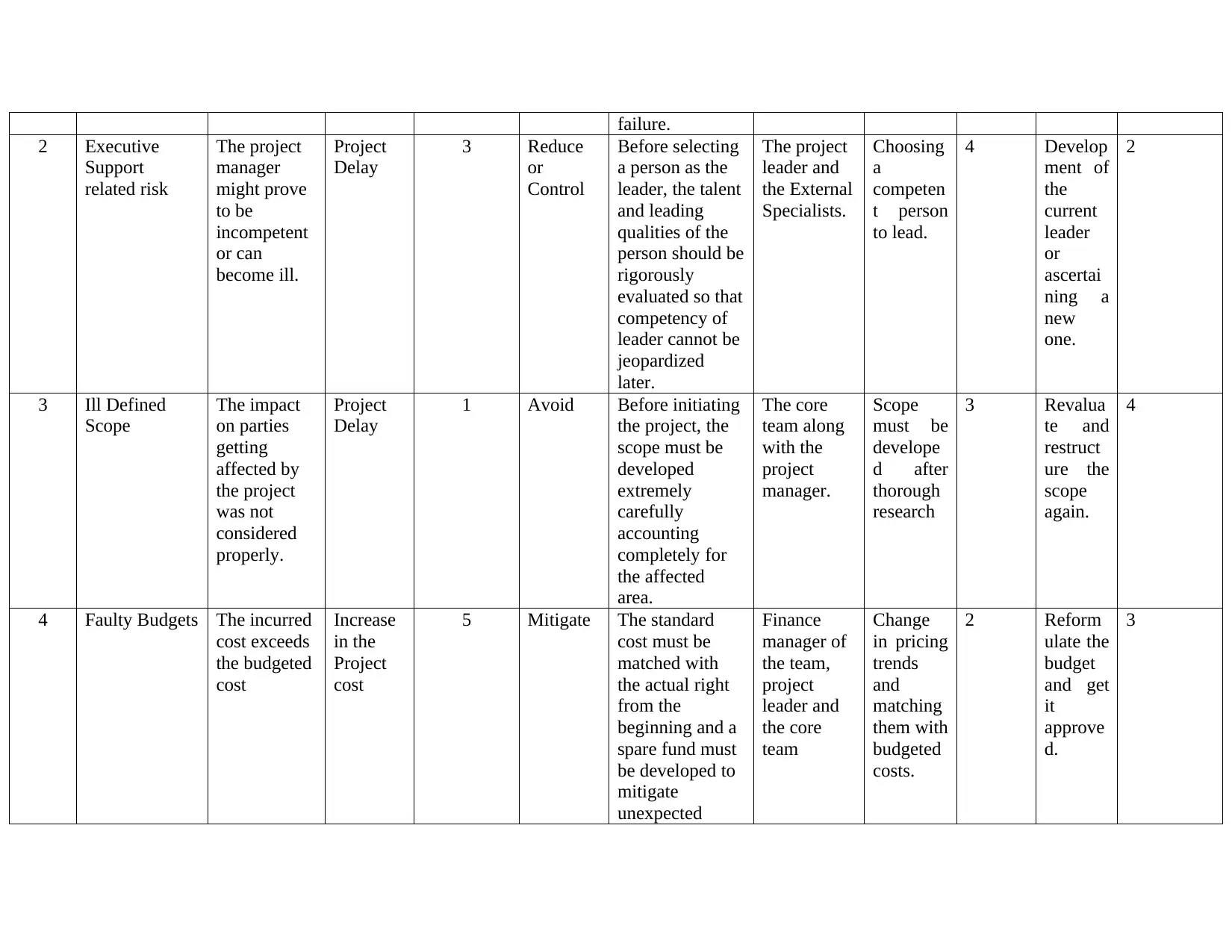
failure.
2 Executive
Support
related risk
The project
manager
might prove
to be
incompetent
or can
become ill.
Project
Delay
3 Reduce
or
Control
Before selecting
a person as the
leader, the talent
and leading
qualities of the
person should be
rigorously
evaluated so that
competency of
leader cannot be
jeopardized
later.
The project
leader and
the External
Specialists.
Choosing
a
competen
t person
to lead.
4 Develop
ment of
the
current
leader
or
ascertai
ning a
new
one.
2
3 Ill Defined
Scope
The impact
on parties
getting
affected by
the project
was not
considered
properly.
Project
Delay
1 Avoid Before initiating
the project, the
scope must be
developed
extremely
carefully
accounting
completely for
the affected
area.
The core
team along
with the
project
manager.
Scope
must be
develope
d after
thorough
research
3 Revalua
te and
restruct
ure the
scope
again.
4
4 Faulty Budgets The incurred
cost exceeds
the budgeted
cost
Increase
in the
Project
cost
5 Mitigate The standard
cost must be
matched with
the actual right
from the
beginning and a
spare fund must
be developed to
mitigate
unexpected
Finance
manager of
the team,
project
leader and
the core
team
Change
in pricing
trends
and
matching
them with
budgeted
costs.
2 Reform
ulate the
budget
and get
it
approve
d.
3
2 Executive
Support
related risk
The project
manager
might prove
to be
incompetent
or can
become ill.
Project
Delay
3 Reduce
or
Control
Before selecting
a person as the
leader, the talent
and leading
qualities of the
person should be
rigorously
evaluated so that
competency of
leader cannot be
jeopardized
later.
The project
leader and
the External
Specialists.
Choosing
a
competen
t person
to lead.
4 Develop
ment of
the
current
leader
or
ascertai
ning a
new
one.
2
3 Ill Defined
Scope
The impact
on parties
getting
affected by
the project
was not
considered
properly.
Project
Delay
1 Avoid Before initiating
the project, the
scope must be
developed
extremely
carefully
accounting
completely for
the affected
area.
The core
team along
with the
project
manager.
Scope
must be
develope
d after
thorough
research
3 Revalua
te and
restruct
ure the
scope
again.
4
4 Faulty Budgets The incurred
cost exceeds
the budgeted
cost
Increase
in the
Project
cost
5 Mitigate The standard
cost must be
matched with
the actual right
from the
beginning and a
spare fund must
be developed to
mitigate
unexpected
Finance
manager of
the team,
project
leader and
the core
team
Change
in pricing
trends
and
matching
them with
budgeted
costs.
2 Reform
ulate the
budget
and get
it
approve
d.
3
Paraphrase This Document
Need a fresh take? Get an instant paraphrase of this document with our AI Paraphraser
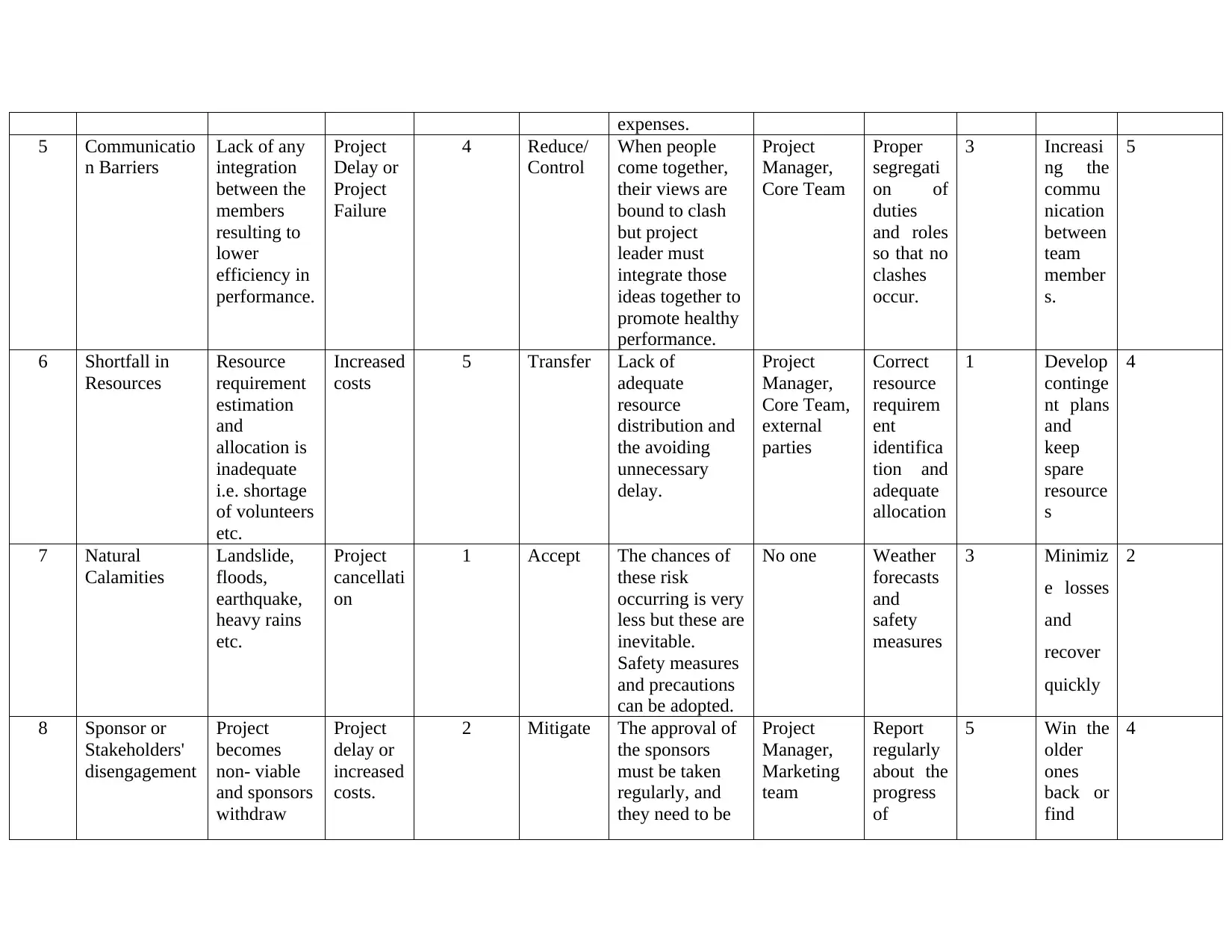
expenses.
5 Communicatio
n Barriers
Lack of any
integration
between the
members
resulting to
lower
efficiency in
performance.
Project
Delay or
Project
Failure
4 Reduce/
Control
When people
come together,
their views are
bound to clash
but project
leader must
integrate those
ideas together to
promote healthy
performance.
Project
Manager,
Core Team
Proper
segregati
on of
duties
and roles
so that no
clashes
occur.
3 Increasi
ng the
commu
nication
between
team
member
s.
5
6 Shortfall in
Resources
Resource
requirement
estimation
and
allocation is
inadequate
i.e. shortage
of volunteers
etc.
Increased
costs
5 Transfer Lack of
adequate
resource
distribution and
the avoiding
unnecessary
delay.
Project
Manager,
Core Team,
external
parties
Correct
resource
requirem
ent
identifica
tion and
adequate
allocation
1 Develop
continge
nt plans
and
keep
spare
resource
s
4
7 Natural
Calamities
Landslide,
floods,
earthquake,
heavy rains
etc.
Project
cancellati
on
1 Accept The chances of
these risk
occurring is very
less but these are
inevitable.
Safety measures
and precautions
can be adopted.
No one Weather
forecasts
and
safety
measures
3 Minimiz
e losses
and
recover
quickly
2
8 Sponsor or
Stakeholders'
disengagement
Project
becomes
non- viable
and sponsors
withdraw
Project
delay or
increased
costs.
2 Mitigate The approval of
the sponsors
must be taken
regularly, and
they need to be
Project
Manager,
Marketing
team
Report
regularly
about the
progress
of
5 Win the
older
ones
back or
find
4
5 Communicatio
n Barriers
Lack of any
integration
between the
members
resulting to
lower
efficiency in
performance.
Project
Delay or
Project
Failure
4 Reduce/
Control
When people
come together,
their views are
bound to clash
but project
leader must
integrate those
ideas together to
promote healthy
performance.
Project
Manager,
Core Team
Proper
segregati
on of
duties
and roles
so that no
clashes
occur.
3 Increasi
ng the
commu
nication
between
team
member
s.
5
6 Shortfall in
Resources
Resource
requirement
estimation
and
allocation is
inadequate
i.e. shortage
of volunteers
etc.
Increased
costs
5 Transfer Lack of
adequate
resource
distribution and
the avoiding
unnecessary
delay.
Project
Manager,
Core Team,
external
parties
Correct
resource
requirem
ent
identifica
tion and
adequate
allocation
1 Develop
continge
nt plans
and
keep
spare
resource
s
4
7 Natural
Calamities
Landslide,
floods,
earthquake,
heavy rains
etc.
Project
cancellati
on
1 Accept The chances of
these risk
occurring is very
less but these are
inevitable.
Safety measures
and precautions
can be adopted.
No one Weather
forecasts
and
safety
measures
3 Minimiz
e losses
and
recover
quickly
2
8 Sponsor or
Stakeholders'
disengagement
Project
becomes
non- viable
and sponsors
withdraw
Project
delay or
increased
costs.
2 Mitigate The approval of
the sponsors
must be taken
regularly, and
they need to be
Project
Manager,
Marketing
team
Report
regularly
about the
progress
of
5 Win the
older
ones
back or
find
4
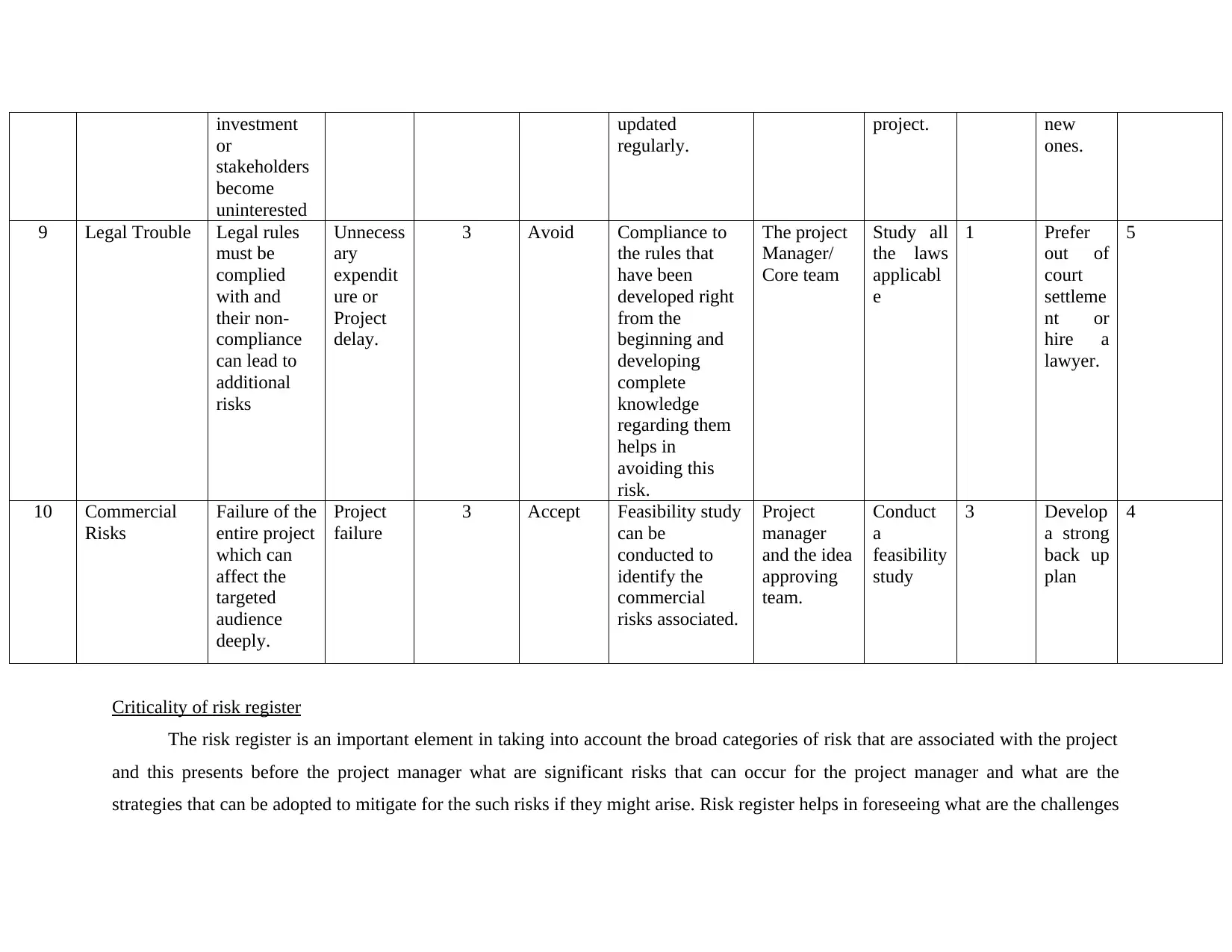
investment
or
stakeholders
become
uninterested
updated
regularly.
project. new
ones.
9 Legal Trouble Legal rules
must be
complied
with and
their non-
compliance
can lead to
additional
risks
Unnecess
ary
expendit
ure or
Project
delay.
3 Avoid Compliance to
the rules that
have been
developed right
from the
beginning and
developing
complete
knowledge
regarding them
helps in
avoiding this
risk.
The project
Manager/
Core team
Study all
the laws
applicabl
e
1 Prefer
out of
court
settleme
nt or
hire a
lawyer.
5
10 Commercial
Risks
Failure of the
entire project
which can
affect the
targeted
audience
deeply.
Project
failure
3 Accept Feasibility study
can be
conducted to
identify the
commercial
risks associated.
Project
manager
and the idea
approving
team.
Conduct
a
feasibility
study
3 Develop
a strong
back up
plan
4
Criticality of risk register
The risk register is an important element in taking into account the broad categories of risk that are associated with the project
and this presents before the project manager what are significant risks that can occur for the project manager and what are the
strategies that can be adopted to mitigate for the such risks if they might arise. Risk register helps in foreseeing what are the challenges
or
stakeholders
become
uninterested
updated
regularly.
project. new
ones.
9 Legal Trouble Legal rules
must be
complied
with and
their non-
compliance
can lead to
additional
risks
Unnecess
ary
expendit
ure or
Project
delay.
3 Avoid Compliance to
the rules that
have been
developed right
from the
beginning and
developing
complete
knowledge
regarding them
helps in
avoiding this
risk.
The project
Manager/
Core team
Study all
the laws
applicabl
e
1 Prefer
out of
court
settleme
nt or
hire a
lawyer.
5
10 Commercial
Risks
Failure of the
entire project
which can
affect the
targeted
audience
deeply.
Project
failure
3 Accept Feasibility study
can be
conducted to
identify the
commercial
risks associated.
Project
manager
and the idea
approving
team.
Conduct
a
feasibility
study
3 Develop
a strong
back up
plan
4
Criticality of risk register
The risk register is an important element in taking into account the broad categories of risk that are associated with the project
and this presents before the project manager what are significant risks that can occur for the project manager and what are the
strategies that can be adopted to mitigate for the such risks if they might arise. Risk register helps in foreseeing what are the challenges
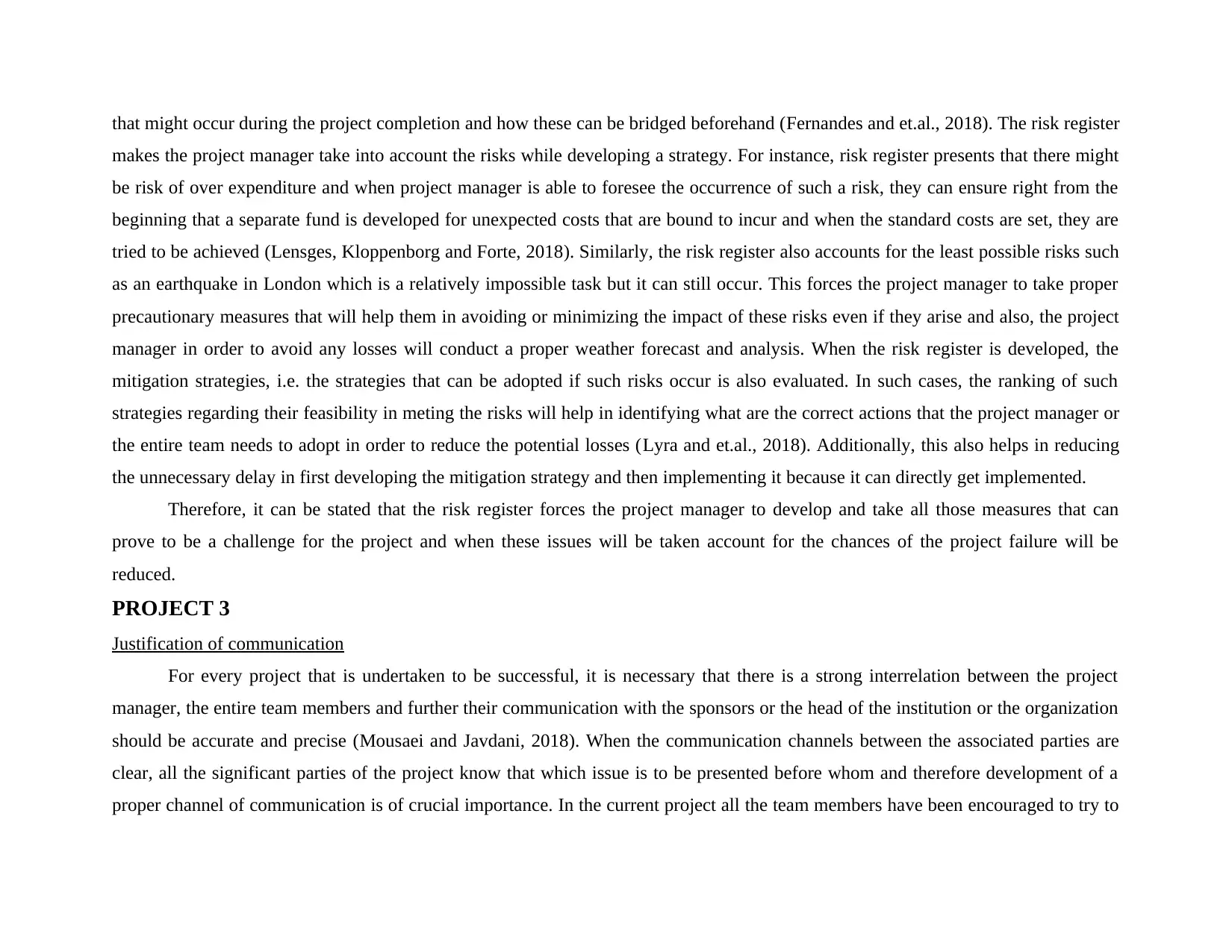
that might occur during the project completion and how these can be bridged beforehand (Fernandes and et.al., 2018). The risk register
makes the project manager take into account the risks while developing a strategy. For instance, risk register presents that there might
be risk of over expenditure and when project manager is able to foresee the occurrence of such a risk, they can ensure right from the
beginning that a separate fund is developed for unexpected costs that are bound to incur and when the standard costs are set, they are
tried to be achieved (Lensges, Kloppenborg and Forte, 2018). Similarly, the risk register also accounts for the least possible risks such
as an earthquake in London which is a relatively impossible task but it can still occur. This forces the project manager to take proper
precautionary measures that will help them in avoiding or minimizing the impact of these risks even if they arise and also, the project
manager in order to avoid any losses will conduct a proper weather forecast and analysis. When the risk register is developed, the
mitigation strategies, i.e. the strategies that can be adopted if such risks occur is also evaluated. In such cases, the ranking of such
strategies regarding their feasibility in meting the risks will help in identifying what are the correct actions that the project manager or
the entire team needs to adopt in order to reduce the potential losses (Lyra and et.al., 2018). Additionally, this also helps in reducing
the unnecessary delay in first developing the mitigation strategy and then implementing it because it can directly get implemented.
Therefore, it can be stated that the risk register forces the project manager to develop and take all those measures that can
prove to be a challenge for the project and when these issues will be taken account for the chances of the project failure will be
reduced.
PROJECT 3
Justification of communication
For every project that is undertaken to be successful, it is necessary that there is a strong interrelation between the project
manager, the entire team members and further their communication with the sponsors or the head of the institution or the organization
should be accurate and precise (Mousaei and Javdani, 2018). When the communication channels between the associated parties are
clear, all the significant parties of the project know that which issue is to be presented before whom and therefore development of a
proper channel of communication is of crucial importance. In the current project all the team members have been encouraged to try to
makes the project manager take into account the risks while developing a strategy. For instance, risk register presents that there might
be risk of over expenditure and when project manager is able to foresee the occurrence of such a risk, they can ensure right from the
beginning that a separate fund is developed for unexpected costs that are bound to incur and when the standard costs are set, they are
tried to be achieved (Lensges, Kloppenborg and Forte, 2018). Similarly, the risk register also accounts for the least possible risks such
as an earthquake in London which is a relatively impossible task but it can still occur. This forces the project manager to take proper
precautionary measures that will help them in avoiding or minimizing the impact of these risks even if they arise and also, the project
manager in order to avoid any losses will conduct a proper weather forecast and analysis. When the risk register is developed, the
mitigation strategies, i.e. the strategies that can be adopted if such risks occur is also evaluated. In such cases, the ranking of such
strategies regarding their feasibility in meting the risks will help in identifying what are the correct actions that the project manager or
the entire team needs to adopt in order to reduce the potential losses (Lyra and et.al., 2018). Additionally, this also helps in reducing
the unnecessary delay in first developing the mitigation strategy and then implementing it because it can directly get implemented.
Therefore, it can be stated that the risk register forces the project manager to develop and take all those measures that can
prove to be a challenge for the project and when these issues will be taken account for the chances of the project failure will be
reduced.
PROJECT 3
Justification of communication
For every project that is undertaken to be successful, it is necessary that there is a strong interrelation between the project
manager, the entire team members and further their communication with the sponsors or the head of the institution or the organization
should be accurate and precise (Mousaei and Javdani, 2018). When the communication channels between the associated parties are
clear, all the significant parties of the project know that which issue is to be presented before whom and therefore development of a
proper channel of communication is of crucial importance. In the current project all the team members have been encouraged to try to
Secure Best Marks with AI Grader
Need help grading? Try our AI Grader for instant feedback on your assignments.
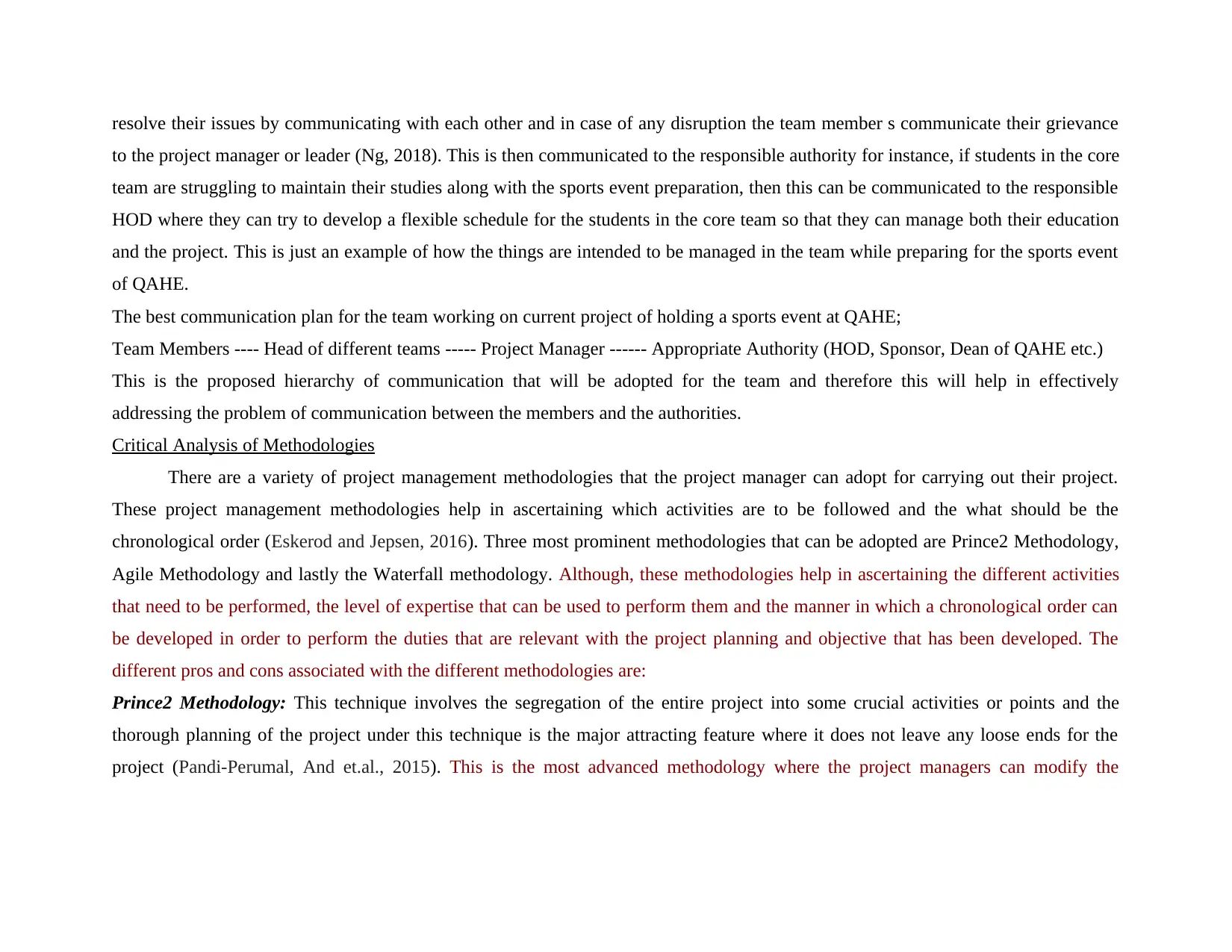
resolve their issues by communicating with each other and in case of any disruption the team member s communicate their grievance
to the project manager or leader (Ng, 2018). This is then communicated to the responsible authority for instance, if students in the core
team are struggling to maintain their studies along with the sports event preparation, then this can be communicated to the responsible
HOD where they can try to develop a flexible schedule for the students in the core team so that they can manage both their education
and the project. This is just an example of how the things are intended to be managed in the team while preparing for the sports event
of QAHE.
The best communication plan for the team working on current project of holding a sports event at QAHE;
Team Members ---- Head of different teams ----- Project Manager ------ Appropriate Authority (HOD, Sponsor, Dean of QAHE etc.)
This is the proposed hierarchy of communication that will be adopted for the team and therefore this will help in effectively
addressing the problem of communication between the members and the authorities.
Critical Analysis of Methodologies
There are a variety of project management methodologies that the project manager can adopt for carrying out their project.
These project management methodologies help in ascertaining which activities are to be followed and the what should be the
chronological order (Eskerod and Jepsen, 2016). Three most prominent methodologies that can be adopted are Prince2 Methodology,
Agile Methodology and lastly the Waterfall methodology. Although, these methodologies help in ascertaining the different activities
that need to be performed, the level of expertise that can be used to perform them and the manner in which a chronological order can
be developed in order to perform the duties that are relevant with the project planning and objective that has been developed. The
different pros and cons associated with the different methodologies are:
Prince2 Methodology: This technique involves the segregation of the entire project into some crucial activities or points and the
thorough planning of the project under this technique is the major attracting feature where it does not leave any loose ends for the
project (Pandi-Perumal, And et.al., 2015). This is the most advanced methodology where the project managers can modify the
to the project manager or leader (Ng, 2018). This is then communicated to the responsible authority for instance, if students in the core
team are struggling to maintain their studies along with the sports event preparation, then this can be communicated to the responsible
HOD where they can try to develop a flexible schedule for the students in the core team so that they can manage both their education
and the project. This is just an example of how the things are intended to be managed in the team while preparing for the sports event
of QAHE.
The best communication plan for the team working on current project of holding a sports event at QAHE;
Team Members ---- Head of different teams ----- Project Manager ------ Appropriate Authority (HOD, Sponsor, Dean of QAHE etc.)
This is the proposed hierarchy of communication that will be adopted for the team and therefore this will help in effectively
addressing the problem of communication between the members and the authorities.
Critical Analysis of Methodologies
There are a variety of project management methodologies that the project manager can adopt for carrying out their project.
These project management methodologies help in ascertaining which activities are to be followed and the what should be the
chronological order (Eskerod and Jepsen, 2016). Three most prominent methodologies that can be adopted are Prince2 Methodology,
Agile Methodology and lastly the Waterfall methodology. Although, these methodologies help in ascertaining the different activities
that need to be performed, the level of expertise that can be used to perform them and the manner in which a chronological order can
be developed in order to perform the duties that are relevant with the project planning and objective that has been developed. The
different pros and cons associated with the different methodologies are:
Prince2 Methodology: This technique involves the segregation of the entire project into some crucial activities or points and the
thorough planning of the project under this technique is the major attracting feature where it does not leave any loose ends for the
project (Pandi-Perumal, And et.al., 2015). This is the most advanced methodology where the project managers can modify the
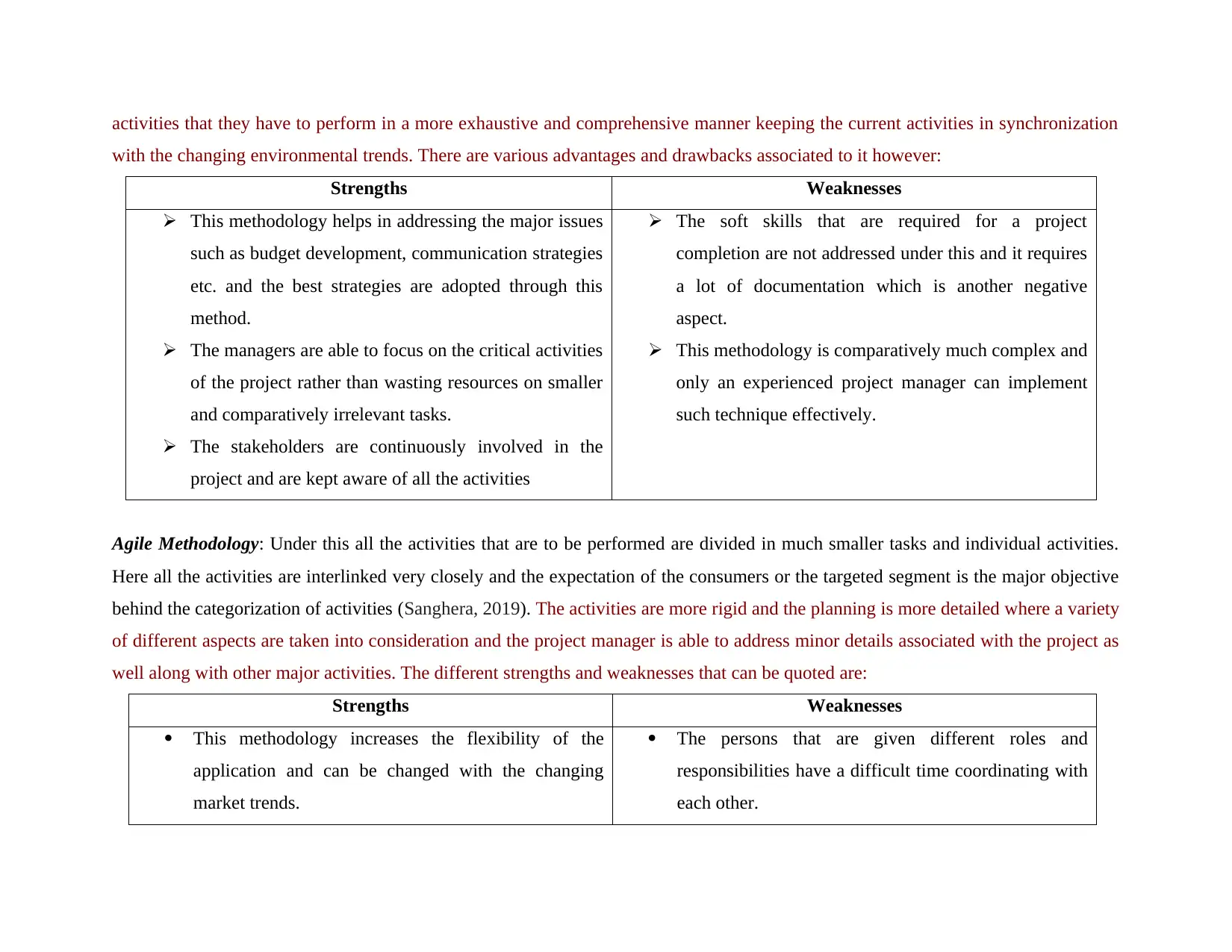
activities that they have to perform in a more exhaustive and comprehensive manner keeping the current activities in synchronization
with the changing environmental trends. There are various advantages and drawbacks associated to it however:
Strengths Weaknesses
This methodology helps in addressing the major issues
such as budget development, communication strategies
etc. and the best strategies are adopted through this
method.
The managers are able to focus on the critical activities
of the project rather than wasting resources on smaller
and comparatively irrelevant tasks.
The stakeholders are continuously involved in the
project and are kept aware of all the activities
The soft skills that are required for a project
completion are not addressed under this and it requires
a lot of documentation which is another negative
aspect.
This methodology is comparatively much complex and
only an experienced project manager can implement
such technique effectively.
Agile Methodology: Under this all the activities that are to be performed are divided in much smaller tasks and individual activities.
Here all the activities are interlinked very closely and the expectation of the consumers or the targeted segment is the major objective
behind the categorization of activities (Sanghera, 2019). The activities are more rigid and the planning is more detailed where a variety
of different aspects are taken into consideration and the project manager is able to address minor details associated with the project as
well along with other major activities. The different strengths and weaknesses that can be quoted are:
Strengths Weaknesses
This methodology increases the flexibility of the
application and can be changed with the changing
market trends.
The persons that are given different roles and
responsibilities have a difficult time coordinating with
each other.
with the changing environmental trends. There are various advantages and drawbacks associated to it however:
Strengths Weaknesses
This methodology helps in addressing the major issues
such as budget development, communication strategies
etc. and the best strategies are adopted through this
method.
The managers are able to focus on the critical activities
of the project rather than wasting resources on smaller
and comparatively irrelevant tasks.
The stakeholders are continuously involved in the
project and are kept aware of all the activities
The soft skills that are required for a project
completion are not addressed under this and it requires
a lot of documentation which is another negative
aspect.
This methodology is comparatively much complex and
only an experienced project manager can implement
such technique effectively.
Agile Methodology: Under this all the activities that are to be performed are divided in much smaller tasks and individual activities.
Here all the activities are interlinked very closely and the expectation of the consumers or the targeted segment is the major objective
behind the categorization of activities (Sanghera, 2019). The activities are more rigid and the planning is more detailed where a variety
of different aspects are taken into consideration and the project manager is able to address minor details associated with the project as
well along with other major activities. The different strengths and weaknesses that can be quoted are:
Strengths Weaknesses
This methodology increases the flexibility of the
application and can be changed with the changing
market trends.
The persons that are given different roles and
responsibilities have a difficult time coordinating with
each other.

The communication with both the stakeholders and the
team members in constant where regular updates are
given to them so that they can be kept informed.
This methodology also involves experienced project
managers and therefore this cannot be applied if the
leader is not familiar with the use of such techniques.
Waterfall Methodology: This type of strategy is used mainly for the projects operating at a smaller scale and under this the next step
or stage is linked critically with the previous ones where they cannot be done separately. Therefore, the next task is initiated only
when the earlier task is effectively completed or achieved (Kliem and Ludin, 2019). This is comparatively a simplified methodology
where the project manager can identify the different trends and a singular development of project activities help in developing a most
feasible option for the completion of the project. However, the strengths and weaknesses of the technique can be categorized
separately:
Strengths Weaknesses
This is a very simplified technique and can be
implemented very easily in the companies or
organizations due to its rigid implementation.
This technique helps in avoiding any overlapping of
the different phases or activities that are to be
performed in the project.
When one single stage is completed, it effectively
becomes impossible to make changes in the older
tasks leaving this technique inflexible and rigid.
When the complexity of the tasks increases, the
applicability of this methodology becomes very
difficult.
This model is an extremely infeasible option for the
projects in the currently dynamic environment.
The analysis above helps in concluding that for the current project of planning and hosting a sports event at QAHE, it is
necessary that the project methodology that is adopted is flexible to be modified and therefore Agile Methodology will be the best
team members in constant where regular updates are
given to them so that they can be kept informed.
This methodology also involves experienced project
managers and therefore this cannot be applied if the
leader is not familiar with the use of such techniques.
Waterfall Methodology: This type of strategy is used mainly for the projects operating at a smaller scale and under this the next step
or stage is linked critically with the previous ones where they cannot be done separately. Therefore, the next task is initiated only
when the earlier task is effectively completed or achieved (Kliem and Ludin, 2019). This is comparatively a simplified methodology
where the project manager can identify the different trends and a singular development of project activities help in developing a most
feasible option for the completion of the project. However, the strengths and weaknesses of the technique can be categorized
separately:
Strengths Weaknesses
This is a very simplified technique and can be
implemented very easily in the companies or
organizations due to its rigid implementation.
This technique helps in avoiding any overlapping of
the different phases or activities that are to be
performed in the project.
When one single stage is completed, it effectively
becomes impossible to make changes in the older
tasks leaving this technique inflexible and rigid.
When the complexity of the tasks increases, the
applicability of this methodology becomes very
difficult.
This model is an extremely infeasible option for the
projects in the currently dynamic environment.
The analysis above helps in concluding that for the current project of planning and hosting a sports event at QAHE, it is
necessary that the project methodology that is adopted is flexible to be modified and therefore Agile Methodology will be the best
Paraphrase This Document
Need a fresh take? Get an instant paraphrase of this document with our AI Paraphraser
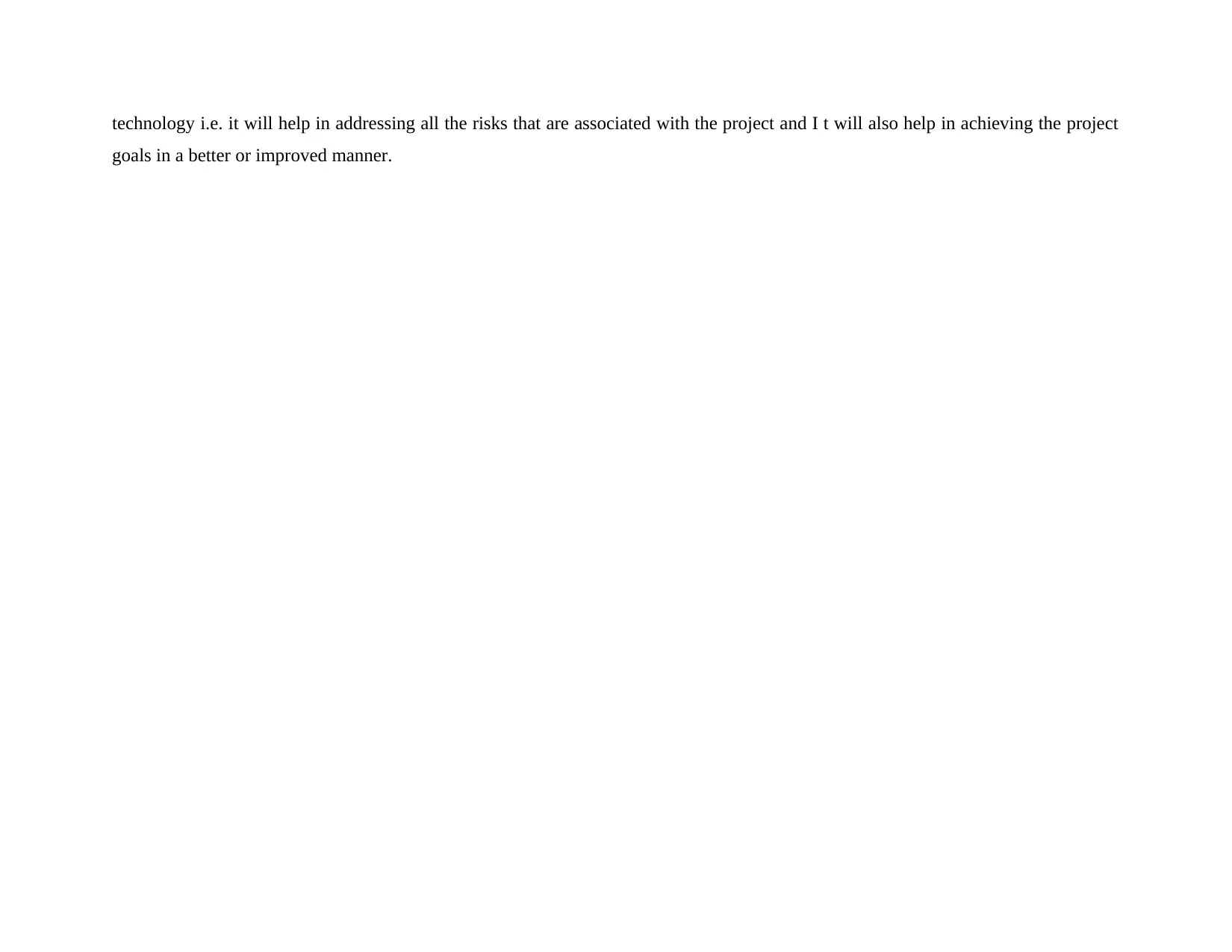
technology i.e. it will help in addressing all the risks that are associated with the project and I t will also help in achieving the project
goals in a better or improved manner.
goals in a better or improved manner.

REFERENCES
Books and journals
Dohe, K. and Pike, R., 2018. Integration of project management techniques in digital projects. In Project management in the library
workplace (pp. 151-166). Emerald Publishing Limited.
Eskerod, P. and Jepsen, A.L., 2016. Project stakeholder management. Routledge.
Fernandes, G. and et.al., 2018. Project Management Practices for Collaborative University-Industry R&D: A Hybrid
Approach. Procedia computer science. 138. pp.805-814.
Fewings, P. and Henjewele, C., 2019. Construction project management: an integrated approach. Routledge.
Heldman, K., 2018. Project management jumpstart. John Wiley & Sons.
Kerzner, H., 2018. Project management best practices: Achieving global excellence. John Wiley & Sons.
Kerzner, H., 2019. Using the project management maturity model: strategic planning for project management. Wiley.
Kliem, R.L. and Ludin, I.S., 2019. Reducing project risk. Routledge.
Lensges, M. L., Kloppenborg, T. J. and Forte, F., 2018. Identifying Key Agile Behaviors That Enhance Traditional Project
Management Methodology. Journal of Strategic Innovation and Sustainability. 13(2).
Lyra, K. T. and et.al., 2018, September. An agile project management experience: points of view of graduate students. In Proceedings
of the XXXII Brazilian Symposium on Software Engineering (pp. 240-249). ACM.
Mousaei, M. and Javdani, T., 2018. A new project risk management model based on scrum framework and Prince2
methodology. International Journal of Advanced Computer Science and Applications. 9.
Ng, J. J., 2018. Tailoring a project management methodology that suits one's needs. IEEE Engineering Management Review. 46(2).
pp.49-54.
Pandi-Perumal, S.R. And et.al., 2015. Project stakeholder management in the clinical research environment: how to do it
right. Frontiers in psychiatry, 6. p.71.
1
Books and journals
Dohe, K. and Pike, R., 2018. Integration of project management techniques in digital projects. In Project management in the library
workplace (pp. 151-166). Emerald Publishing Limited.
Eskerod, P. and Jepsen, A.L., 2016. Project stakeholder management. Routledge.
Fernandes, G. and et.al., 2018. Project Management Practices for Collaborative University-Industry R&D: A Hybrid
Approach. Procedia computer science. 138. pp.805-814.
Fewings, P. and Henjewele, C., 2019. Construction project management: an integrated approach. Routledge.
Heldman, K., 2018. Project management jumpstart. John Wiley & Sons.
Kerzner, H., 2018. Project management best practices: Achieving global excellence. John Wiley & Sons.
Kerzner, H., 2019. Using the project management maturity model: strategic planning for project management. Wiley.
Kliem, R.L. and Ludin, I.S., 2019. Reducing project risk. Routledge.
Lensges, M. L., Kloppenborg, T. J. and Forte, F., 2018. Identifying Key Agile Behaviors That Enhance Traditional Project
Management Methodology. Journal of Strategic Innovation and Sustainability. 13(2).
Lyra, K. T. and et.al., 2018, September. An agile project management experience: points of view of graduate students. In Proceedings
of the XXXII Brazilian Symposium on Software Engineering (pp. 240-249). ACM.
Mousaei, M. and Javdani, T., 2018. A new project risk management model based on scrum framework and Prince2
methodology. International Journal of Advanced Computer Science and Applications. 9.
Ng, J. J., 2018. Tailoring a project management methodology that suits one's needs. IEEE Engineering Management Review. 46(2).
pp.49-54.
Pandi-Perumal, S.R. And et.al., 2015. Project stakeholder management in the clinical research environment: how to do it
right. Frontiers in psychiatry, 6. p.71.
1

Sanghera, P., 2019. Monitoring Stakeholder Engagement and Communication. In PMP® in Depth (pp. 519-533). Apress, Berkeley,
CA.
2
CA.
2
1 out of 19
Related Documents
Your All-in-One AI-Powered Toolkit for Academic Success.
+13062052269
info@desklib.com
Available 24*7 on WhatsApp / Email
![[object Object]](/_next/static/media/star-bottom.7253800d.svg)
Unlock your academic potential
© 2024 | Zucol Services PVT LTD | All rights reserved.





